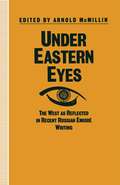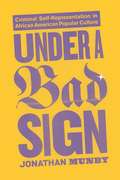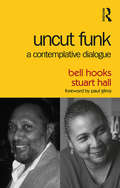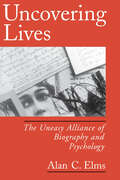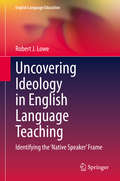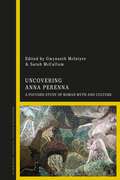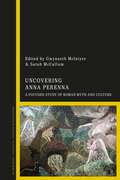- Table View
- List View
Under the Cover: The Creation, Production, and Reception of a Novel
by Clayton ChildressUnder the Cover follows the life trajectory of a single work of fiction from its initial inspiration to its reception by reviewers and readers. The subject is Jarrettsville, a historical novel by Cornelia Nixon, which was published in 2009 and based on an actual murder committed by an ancestor of Nixon's in the postbellum South.Clayton Childress takes you behind the scenes to examine how Jarrettsville was shepherded across three interdependent fields—authoring, publishing, and reading—and how it was transformed by its journey. Along the way, he covers all aspects of the life of a book, including the author's creative process, the role of the literary agent, how editors decide which books to acquire, how publishers build lists and distinguish themselves from other publishers, how they sell a book to stores and publicize it, and how authors choose their next projects. Childress looks at how books get selected for the front tables in bookstores, why reviewers and readers can draw such different meanings from the same novel, and how book groups across the country make sense of a novel and what it means to them.Drawing on original survey data, in-depth interviews, and groundbreaking ethnographic fieldwork, Under the Cover reveals how decisions are made, inequalities are reproduced, and novels are built to travel in the creation, production, and consumption of culture.
Under the Cover: The Creation, Production, and Reception of a Novel
by Clayton ChildressUnder the Cover follows the life trajectory of a single work of fiction from its initial inspiration to its reception by reviewers and readers. The subject is Jarrettsville, a historical novel by Cornelia Nixon, which was published in 2009 and based on an actual murder committed by an ancestor of Nixon's in the postbellum South.Clayton Childress takes you behind the scenes to examine how Jarrettsville was shepherded across three interdependent fields—authoring, publishing, and reading—and how it was transformed by its journey. Along the way, he covers all aspects of the life of a book, including the author's creative process, the role of the literary agent, how editors decide which books to acquire, how publishers build lists and distinguish themselves from other publishers, how they sell a book to stores and publicize it, and how authors choose their next projects. Childress looks at how books get selected for the front tables in bookstores, why reviewers and readers can draw such different meanings from the same novel, and how book groups across the country make sense of a novel and what it means to them.Drawing on original survey data, in-depth interviews, and groundbreaking ethnographic fieldwork, Under the Cover reveals how decisions are made, inequalities are reproduced, and novels are built to travel in the creation, production, and consumption of culture.
Under the Bhasha Gaze: Modernity and Indian Literature
by Prof PP RaveendranThe book is a study of literature in India in the context of recent discussions on modernity and its theoretical extensions such as the everyday and the social imaginary. It is a critique of the aesthetics and politics of modernity as they are embodied in Indian bhasha literature of the past two centuries. The primary objective of the book is to explore the trajectory of modernity after Indian literature encountered colonialism in the early 19th century. The intricate ways in which the bhasha imagination negotiated questions around concepts such as colonialism, aesthetics, the literary, the historical, and the social, have received focused attention in the analysis. Although the study acknowledges the European provenance of modernity as a historical idea, it also recognizes the inherent complexity of the concept and its equivocal connotations when used with reference to the polyphonic bhasha communities in India. Theoretical issues debated in relation to modernity such as its conceptual affinities with the western enlightenment project, its ideological investment in European aesthetics, and its implication for the evolution of what might be called the hermetic aesthetic are significant to this study. The work also examines the regional strengths of the social imaginary that render a conventionally conceived modernity inadequate in explaining the uniquely modern strengths of the Indian bhasha imagination.
Under the Bhasha Gaze: Modernity and Indian Literature
by Prof PP RaveendranThe book is a study of literature in India in the context of recent discussions on modernity and its theoretical extensions such as the everyday and the social imaginary. It is a critique of the aesthetics and politics of modernity as they are embodied in Indian bhasha literature of the past two centuries. The primary objective of the book is to explore the trajectory of modernity after Indian literature encountered colonialism in the early 19th century. The intricate ways in which the bhasha imagination negotiated questions around concepts such as colonialism, aesthetics, the literary, the historical, and the social, have received focused attention in the analysis. Although the study acknowledges the European provenance of modernity as a historical idea, it also recognizes the inherent complexity of the concept and its equivocal connotations when used with reference to the polyphonic bhasha communities in India. Theoretical issues debated in relation to modernity such as its conceptual affinities with the western enlightenment project, its ideological investment in European aesthetics, and its implication for the evolution of what might be called the hermetic aesthetic are significant to this study. The work also examines the regional strengths of the social imaginary that render a conventionally conceived modernity inadequate in explaining the uniquely modern strengths of the Indian bhasha imagination.
Under Pressure: Coal Industry Rhetoric and Neoliberalism (Palgrave Studies in Media and Environmental Communication)
by Jen Schneider Steve Schwarze Peter K. Bsumek Jennifer PeeplesThis book examines five rhetorical strategies used by the US coal industry to advance its interests in the face of growing economic and environmental pressures: industrial apocalyptic, corporate ventriloquism, technological shell game, hypocrite’s trap, and energy utopia. The authors argue that these strategies appeal to and reinforce neoliberalism, a discourse and set of practices that privilege market rationality and individual freedom and responsibility above all else. As the coal industry has become the leading target and leverage point for those seeking more aggressive action to mitigate climate change, their corporate advocacy may foreshadow rhetorical strategies available to other fossil fuel industries as they manage similar economic and cultural shifts. The authors’ analysis of coal’s corporate advocacy also identifies contradictions and points of vulnerability in the organized resistance to climate action as well as the larger ideological formation of neoliberalism.
Under Eastern Eyes: The West as Reflected in Recent Russian Emigre Writing (Studies in Russia and East Europe)
by Arnold McMillinThis collection of essays concerns perceptions of the West as reflected in the work of Russian writers of the Third Wave of emigration. The authors include several well-known writers such as Aksenov, Gladilin, Zinik and Loseff as well as Soviet and Western scholars, and the result is both varied and surprising: in the light it throws on the Russian mentality, on the phenomenon of exile and on aspects of the West. It will interest students of contemporary literature, of the Soviet mentality, and of exile in general.
Under Construction
by Christine FarrisFew composition scholars two decades ago would have imagined the rate at which their field is now developing, expanding beyond its boundaries, creating new alliances, and locating new sites for research and generation of knowledge. In their introduction to this volume, Farris and Anson argue that, faced with a welter of competing models, compositionists too quickly dichotomize and dismiss. The contributors to Under Construction, therefore, address themselves to the need for commerce among competing visions of the field. They represent diverse settings and distinct points of view, but their over-riding interest is in promoting a view of the field that values interaction and mutual development above dogmatics and isolation.
Under a Bad Sign: Criminal Self-Representation in African American Popular Culture
by Jonathan MunbyWhat accounts for the persistence of the figure of the black criminal in popular culture created by African Americans? Unearthing the overlooked history of art that has often seemed at odds with the politics of civil rights and racial advancement, Under a Bad Sign explores the rationale behind this tradition of criminal self-representation from the Harlem Renaissance to contemporary gangsta culture. In this lively exploration, Jonathan Munby takes a uniquely broad view, laying bare the way the criminal appears within and moves among literary, musical, and visual arts. Munby traces the legacy of badness in Rudolph Fisher and Chester Himes’s detective fiction and in Claude McKay, Julian Mayfield, and Donald Goines’s urban experience writing. Ranging from Peetie Wheatstraw’s gangster blues to gangsta rap, he also examines criminals in popular songs. Turning to the screen, the underworld films of Oscar Micheaux and Ralph Cooper, the 1970s blaxploitation cycle, and the 1990s hood movie come under his microscope as well. Ultimately, Munby concludes that this tradition has been a misunderstood aspect of African American civic life and that, rather than undermining black culture, it forms a rich and enduring response to being outcast in America.
Under a Bad Sign: Criminal Self-Representation in African American Popular Culture
by Jonathan MunbyWhat accounts for the persistence of the figure of the black criminal in popular culture created by African Americans? Unearthing the overlooked history of art that has often seemed at odds with the politics of civil rights and racial advancement, Under a Bad Sign explores the rationale behind this tradition of criminal self-representation from the Harlem Renaissance to contemporary gangsta culture. In this lively exploration, Jonathan Munby takes a uniquely broad view, laying bare the way the criminal appears within and moves among literary, musical, and visual arts. Munby traces the legacy of badness in Rudolph Fisher and Chester Himes’s detective fiction and in Claude McKay, Julian Mayfield, and Donald Goines’s urban experience writing. Ranging from Peetie Wheatstraw’s gangster blues to gangsta rap, he also examines criminals in popular songs. Turning to the screen, the underworld films of Oscar Micheaux and Ralph Cooper, the 1970s blaxploitation cycle, and the 1990s hood movie come under his microscope as well. Ultimately, Munby concludes that this tradition has been a misunderstood aspect of African American civic life and that, rather than undermining black culture, it forms a rich and enduring response to being outcast in America.
Under a Bad Sign: Criminal Self-Representation in African American Popular Culture
by Jonathan MunbyWhat accounts for the persistence of the figure of the black criminal in popular culture created by African Americans? Unearthing the overlooked history of art that has often seemed at odds with the politics of civil rights and racial advancement, Under a Bad Sign explores the rationale behind this tradition of criminal self-representation from the Harlem Renaissance to contemporary gangsta culture. In this lively exploration, Jonathan Munby takes a uniquely broad view, laying bare the way the criminal appears within and moves among literary, musical, and visual arts. Munby traces the legacy of badness in Rudolph Fisher and Chester Himes’s detective fiction and in Claude McKay, Julian Mayfield, and Donald Goines’s urban experience writing. Ranging from Peetie Wheatstraw’s gangster blues to gangsta rap, he also examines criminals in popular songs. Turning to the screen, the underworld films of Oscar Micheaux and Ralph Cooper, the 1970s blaxploitation cycle, and the 1990s hood movie come under his microscope as well. Ultimately, Munby concludes that this tradition has been a misunderstood aspect of African American civic life and that, rather than undermining black culture, it forms a rich and enduring response to being outcast in America.
The Undeclared War between Journalism and Fiction: Journalists as Genre Benders in Literary History
by D. UnderwoodIn this volume, Doug Underwood asks whether much of what is now called literary journalism is, in fact, 'literary,' and whether it should rank with the great novels by such journalist-literary figures as Twain, Cather, and Hemingway, who believed that fiction was the better place for a realistic writer to express the important truths of life.
"... und sogar eine alberne Ordnung ist immer noch besser als gar keine.": Erzählstrategien in Thomas Manns Roman "Doktor Faustus"
by Gerhard Kaiser"Das Mißraten des Romans kann wohl keinem Zweifel mehr unterliegen , notiert Thomas Mann, nachdem er die Hälfte des Doktor Faustus niedergeschrieben hat. In der Tat manifestiert sich im vieldiskutierten Altersroman gegen den Willen des Autors gleichsam ein "Sieg" des Stoffes, d.h. der im Roman erzählten Wirklichkeiten, über die ordnende Form. Das vorliegende Buch liefert eine stringente Analyse der komplexen Gestaltung des Erzählaktes im Faustus , den Mann selbst als sein "wildestes Buch" bezeichnet. Jedoch erst vor dem Hintergrund mentalitätsgeschichtlicher Erörterungen werden jene spezifisch bildungsbürgerlichen Deutungsmuster sichtbar, welche das ambitionierte Ziel des Autors ermöglichen, das individuelle Schicksal eines modernen Künstlers mit dem Schicksal der "deutschen Nation" und der gesamten Epoche symbolisch zu verknüpfen.
Und Sagte Kein Einziges Wort
by Heinrich BollIncludes the full German text, accompanied by German-English vocabulary. Notes and a detailed introduction in English put the work in its social and historical context.
Und Sagte Kein Einziges Wort
by Heinrich BollIncludes the full German text, accompanied by German-English vocabulary. Notes and a detailed introduction in English put the work in its social and historical context.
Uncut Funk: A Contemplative Dialogue
by bell hooks Stuart HallIn an awesome meeting of minds, cultural theorists Stuart Hall and bell hooks met for a series of wide-ranging conversations on what Hall sums up as "life, love, death, sex." From the trivial to the profound, across boundaries of age, sexualities and genders, hooks and Hall dissect topics and themes of continual contemporary relevance, including feminism, home and homecoming, class, black masculinity, family, politics, relationships, and teaching. In their fluid and honest dialogue they push and pull each other as well as the reader, and the result is a book that speaks to the power of conversation as a place of critical pedagogy.
Uncut Funk: A Contemplative Dialogue
by bell hooks Stuart HallIn an awesome meeting of minds, cultural theorists Stuart Hall and bell hooks met for a series of wide-ranging conversations on what Hall sums up as "life, love, death, sex." From the trivial to the profound, across boundaries of age, sexualities and genders, hooks and Hall dissect topics and themes of continual contemporary relevance, including feminism, home and homecoming, class, black masculinity, family, politics, relationships, and teaching. In their fluid and honest dialogue they push and pull each other as well as the reader, and the result is a book that speaks to the power of conversation as a place of critical pedagogy.
Uncovering the Hidden: The Works and Life of Der Nister
by Gennady EstraikhDer Nister (Pinkhes Kahanovitsh, 1884-1950) is widely regarded as the most enigmatic author in modern Yiddish literature. His pseudonym, which translates as 'The Hidden One', is as puzzling as his diverse body of works, which range from mystical symbolist poetry and dark expressionist tales to realist historical epic. Although part of the Kiev Group of Yiddish writers, which also included David Bergelson and Peretz Markish, Der Nister remained at the margins of the Yiddish literary world throughout his life, mainstream success eluding him both in- and outside the Soviet Union. Yet, to judge from the quantity of recent research and translation work, der Nister is today one of the best remembered Yiddish modernists. The present collection of twelve original articles by international scholars re-examines Der Nister's cultural and literary legacy, bringing to light new aspects of his life and creative output.
Uncovering the Hidden: The Works and Life of Der Nister
by Gennady EstraikhDer Nister (Pinkhes Kahanovitsh, 1884-1950) is widely regarded as the most enigmatic author in modern Yiddish literature. His pseudonym, which translates as 'The Hidden One', is as puzzling as his diverse body of works, which range from mystical symbolist poetry and dark expressionist tales to realist historical epic. Although part of the Kiev Group of Yiddish writers, which also included David Bergelson and Peretz Markish, Der Nister remained at the margins of the Yiddish literary world throughout his life, mainstream success eluding him both in- and outside the Soviet Union. Yet, to judge from the quantity of recent research and translation work, der Nister is today one of the best remembered Yiddish modernists. The present collection of twelve original articles by international scholars re-examines Der Nister's cultural and literary legacy, bringing to light new aspects of his life and creative output.
Uncovering Ideology in English Language Teaching: Identifying the 'Native Speaker' Frame (English Language Education #19)
by Robert J. LoweThis book introduces the concept of the ‘native speaker’ frame: a perceptual filter within English Language Teaching (ELT) which views the linguistic and cultural norms and the educational technology of the anglophone West as being normative, while the norms and practices of non-Western countries are viewed as deficient. Based on a rich source of ethnographic data, and employing a frame analysis approach, it investigates the ways in which this ‘native-speaker’ framing influenced the construction and operation of a Japanese university EFL program. While the program appeared to be free of explicit expressions of native-speakerism, such as discrimination against teachers, this study found that the practices of the program were underpinned by implicitly native-speakerist assumptions based on the stereotyping of Japanese students and the Japanese education system. The book provides a new perspective on debates around native-speakerism by examining how the dominant framing of a program may still be influenced by the ideology, even in cases where overt signs of native-speakerism appear to be absent.
Uncovering Anna Perenna: A Focused Study of Roman Myth and Culture
by Gwynaeth McIntyre Sarah McCallumThe figure of Anna Perenna embodies the complexity and richness of the Roman mythological tradition. In exploring Anna Perenna, the contributors apply different perspectives and critical methods to an array of compelling evidence drawn from central texts, monuments, coins, and inscriptions that encapsulate Rome's shifting artistic and political landscape. As a collection, Uncovering Anna Perenna provides a unique examination that represents the interdisciplinary intersection between Roman literature, history, and culture.The assembled chapters offer thought-provoking and insightful discussions written by specialists in Roman myth and religion, literary studies, and ancient history. A convergence of different perspectives within the collection, including comparative literature, gender and sexuality, literary criticism, and reception, results in a rich and varied investigation. Organized into four parts, the volume explores Anna along four conceptual lines: her liminal nature as a Carthaginian figure coopted into Rome's literary, mythological, and artistic heritage; her capacity as a Roman goddess and nymph; her political and cultural associations with plebeian and populist ideology; and her intriguing influence on James Joyce's Finnegans Wake.
Uncovering Anna Perenna: A Focused Study of Roman Myth and Culture
by Gwynaeth McIntyre Sarah McCallumThe figure of Anna Perenna embodies the complexity and richness of the Roman mythological tradition. In exploring Anna Perenna, the contributors apply different perspectives and critical methods to an array of compelling evidence drawn from central texts, monuments, coins, and inscriptions that encapsulate Rome's shifting artistic and political landscape. As a collection, Uncovering Anna Perenna provides a unique examination that represents the interdisciplinary intersection between Roman literature, history, and culture.The assembled chapters offer thought-provoking and insightful discussions written by specialists in Roman myth and religion, literary studies, and ancient history. A convergence of different perspectives within the collection, including comparative literature, gender and sexuality, literary criticism, and reception, results in a rich and varied investigation. Organized into four parts, the volume explores Anna along four conceptual lines: her liminal nature as a Carthaginian figure coopted into Rome's literary, mythological, and artistic heritage; her capacity as a Roman goddess and nymph; her political and cultural associations with plebeian and populist ideology; and her intriguing influence on James Joyce's Finnegans Wake.
Unconscious Structure in "The Idiot": A Study in Literature and Psychoanalysis
by Elizabeth DaltonArguing that psychoanalytic method enlarges and enriches the significance of literature by discovering a fundamental unconscious structure governing meaning and form in the literary text, Elizabeth Dalton presents both a new and lucid reformulation of the theory of psychoanalytic criticism and a penetrating study of Dostoevsky's great novel, The Idiot. In answering the objections to psychoanalytic criticism, she contends that the method—if properly understood—can be used without falling into reductionism and without recourse to the author's biography. She then deals with such crucial issues as the connections between dreams and literary creation, the role of repression in art, the relationship between creativity and psychopathology, and the unconscious aspects of language. Demonstrating this approach in a radical and comprehensive interpretation of Dostoevsky's novel, the author shows how the enigmatic character of Prince Myshkin, his epilepsy, his mystical insights, his love of Nastasya, and his mysterious involvement with her murderer are all related in a complex pattern of unconscious conflict and fantasy derived from the most primitive and powerful motifs of psychic life. Professor Dalton's pursuit of unconscious connections into virtually every detail of the novel, accounting for subplots, minor characters, and even for the puzzling flaws in the narrative, fully establishes the importance of psychoanalysis for the study of literature.Originally published in 1979.The Princeton Legacy Library uses the latest print-on-demand technology to again make available previously out-of-print books from the distinguished backlist of Princeton University Press. These editions preserve the original texts of these important books while presenting them in durable paperback and hardcover editions. The goal of the Princeton Legacy Library is to vastly increase access to the rich scholarly heritage found in the thousands of books published by Princeton University Press since its founding in 1905.
The Unconscious (The New Critical Idiom)
by Anthony EasthopeThe unconscious is a term which is central to the understanding of psychoanalysis, and, indeed everyday life. In this introductory guide, Antony Easthope provides a witty and accessible overview of the subject showing the reality of the unconscious with a startling variety of examples. He takes us on a vivid guided tour of this troubling topic via jokes, rugby songs, Hamlet, Hitchcock's Psycho, and the life and death of Princess Di. Aimed at the absolute beginner, The Unconscious is an enjoyable and easy-to-read introduction for the student and general reader.
The Unconscious (The New Critical Idiom)
by Anthony EasthopeThe unconscious is a term which is central to the understanding of psychoanalysis, and, indeed everyday life. In this introductory guide, Antony Easthope provides a witty and accessible overview of the subject showing the reality of the unconscious with a startling variety of examples. He takes us on a vivid guided tour of this troubling topic via jokes, rugby songs, Hamlet, Hitchcock's Psycho, and the life and death of Princess Di. Aimed at the absolute beginner, The Unconscious is an enjoyable and easy-to-read introduction for the student and general reader.



